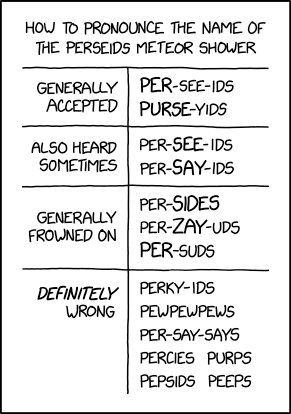
First attempt was the early morning of the 11th down at Jordan Lake, which was both the most successful and the most curious, from a strictly viewing standpoint anyway: I saw several meteors, including one long, slow orange one that was in sight for literally three seconds (I was counting,) as it etched its way across the sky – out of the field of view of the camera, naturally. Now, there is always a guide for meteor showers, which is how they’re named the way they are, because tracing their path back to an apparent origin often reveals a common point, a radiant, which in this case is within the constellation of Perseus. I’ve seen plenty of composite (Photoshopped) images showing a plethora of meteors all emanating from the radiant – except that, in years of being out during showers and storms, I’ve barely seen the evidence of this myself. Even during the spectacular Leonids of 2001, meteors appeared all over the sky, in all directions, and it was only during the peak hour that more seemed to be coming from the radiant, but the most amazing ones were well away and traveling in the opposite direction, so concentrating on only the radiant is potentially a huge waste of time, and I always suggest finding the clearest, darkest portion of sky for best visibility of what does appear. For this particular three-second meteor, it was traveling past and underneath the radiant and in the opposite direction, but the sky was quite bright in that direction (looking towards the border between Durham and Raleigh,) and so I wasn’t aimed there because time exposures had to be very brief to prevent overexposing the image.
There was one that should, by all rights, have been in the frame, but it was brief and boring and subsequent examinations showed nothing at all; it was either just outside the frame, or too dim to register at my settings. On subsequent sessions, I switched over to using the Tamron 10-24 at 10mm, quite a wide field of view, and f3.5 to 5.6 at ISO 1600 to counteract this. While this increases the chances of capturing one (and appears to have worked – we’re getting to that,) it also makes everything in the frame smaller and requires shorter exposure times to prevent overexposure, especially if there’s any scattered light.
But I did get a nice skyscape that morning, at least:

This is at 18mm, 28 seconds at f3.5, ISO 3200 – a quite dark portion of the sky, but the Milky Way came out nice. It’s been color-corrected from the original Sunlight white-balance, which left the image yellowish-green from the residual city lights off of the humidity in the sky. Don’t bother looking for meteors, though for one of these frames I’d just finished aiming the camera, looked up at the sky right before opening the shutter, and watched one pass through the field of view. Typical.
Another from that night, which was pretty clear:
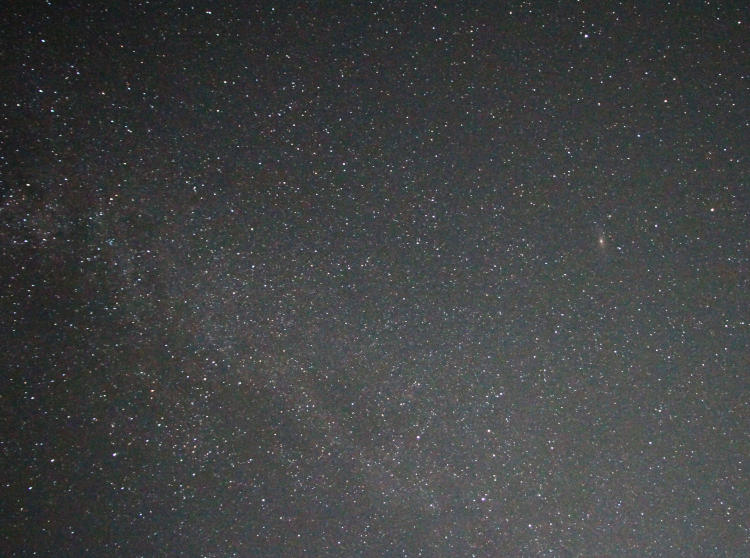
The exposure brought out even faint stars and crowded a lot of things together, reducing the apparent brightness of the brighter stars, but the Milky Way is cutting diagonally across the frame, with Cassiopeia getting cut off at lower center. Cassiopeia is an ‘M’ or ‘W’ shaped constellation that’s fairly easy to spot, but really kind of lost in this frame, and in a line off of the taller of the peaks, as if it was an arrow, sits the Andromeda galaxy – that’s the fuzzy blob to center right. This screen capture from Stellarium labels things a bit better:
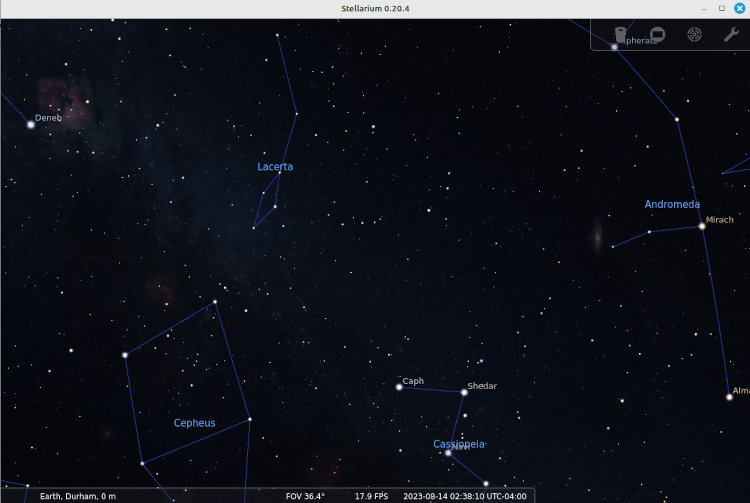
This is largely the same field of view, though showing more on the left than my frame, but most of the ‘M’ of Cassiopeia shows at bottom, and the Andromeda galaxy is the blob that sits off of the arm of the Andromeda constellation.
That same night, I saw, twice, a singular flare of light, not moving – I don’t know for sure what this was. While it could have been a meteor that came ‘straight in’ to my position, those are rare, and seeing one twice is exceptionally so. But what else was it? It’s easy to believe there was movement that I just couldn’t register, but it seems that, if it was so slight, how then could the atmosphere heat up enough for it to glow? [That’s actually what you’re seeing for most meteors: the superheated air from its passage, not the rock itself glowing, though occasionally ablated material creates a color-cast.] There’s a slim chance it might have been something else, and so we have another curiosity, from the following night. First, the full frame:
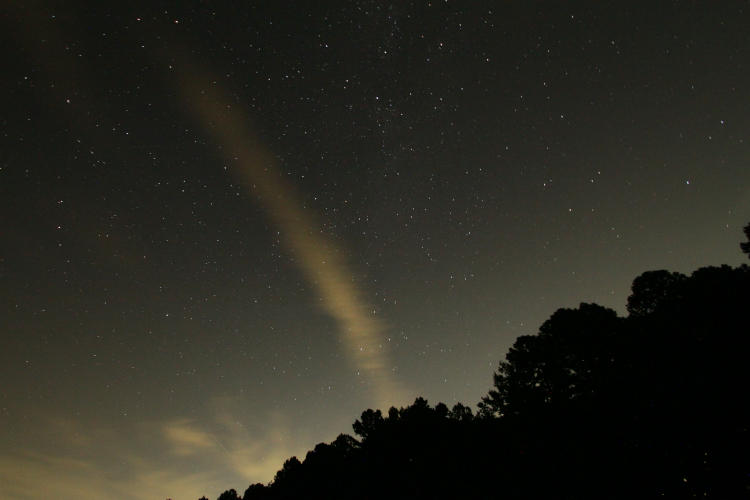
There were scattered, high-altitude clouds that evening, which is the band that you see here, likely a long-lived jet contrail. The curious thing doesn’t even show in this image, but right at the tail-end of the exposure, I caught a glimpse of something as I looked back into the field of view (I don’t spend my entire time staring at the same patch of sky,) and so I chimped at the resulting image, zoomed in tight, and found evidence – and then had a hard time finding it again back home when unloaded. But here it is at full resolution, from off near the left side of the frame:

Okay, that’s not any kind of meteor that I’ve ever seen – I’ve seen plenty of variations in brightness, but not repeated and as periodic as this. So I want to say ‘firefly,’ but it’s not only perfectly straight, it has a faint glow between the bright flashes and extending far to either end, which I’ve never seen from a firefly, and there doesn’t seem to be the yellowish-green color cast that they typically have. Not an airplane, because no marker lights – I have plenty of those, and even at a great distance they’re distinct, plus nothing at all in subsequent frames. Not likely a satellite, because it was 11 PM and the sun would have been almost completely on the other side of the planet and unlikely to reflect from something, not to mention this was nearly due north, and again, nothing in subsequent frames. So it remains a mystery at this point.
The activity during that second session was minimal and the clouds were starting to thicken, so I wrapped it up, but not before doing a few wider, scenic shots like this one:
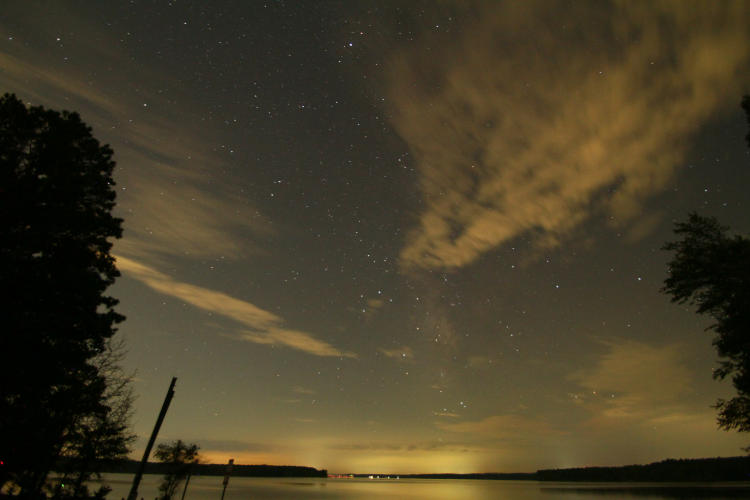
This is uncorrected, Sunlight white balance, which means no alteration from what was out there, but of course it’s a long exposure of conditions that appeared much darker, and the color cast wasn’t as apparent to me when there. I did a shifted version of it:

This seems more natural, if you ignore the distortion at the edges from the wide angle lens. The Milky Way is showing through at lower center – this is looking pretty much due south. From this point, the clouds were getting worse and I’d seen very little, so I wrapped it up for the night.
On stepping outside the next night, the conditions looked promising and I decided to try a different location at Falls Lake instead, about 25 kilometers away (I was guessing half that, but oh well.) This was a mistake, as I discovered when I arrived and was greeted with a thick haze obscuring all but the brightest stars, which had not been present at all when I’d left.

My images gave the impression that we’d entered a nebula, and things weren’t looking too promising. The bright ‘star’ here is actually Jupiter, with the second brightest being Capella. Cassiopeia shows relatively distinctly just left of top center, this time showing the ‘M’ shape better with the peaks pointing right, though in these conditions forget about Andromeda. Which places the Perseus constellation, specifically the radiant of this shower, not too far from the middle of this frame – I was guesstimating the location from memory. But here, I’ve marked it for you.
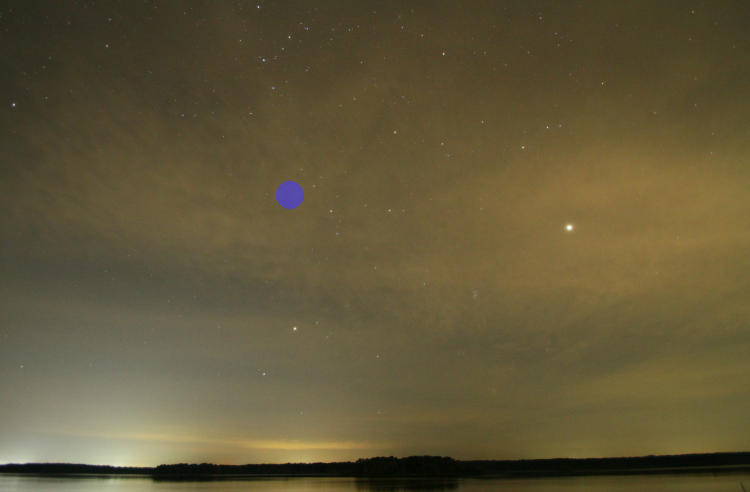
Still, I’d driven out there, so I was willing to give it a shot, even just to see if there was activity. And indeed, there was. Not too long into the session, I clearly saw a meteor where it should have been inside the frame, and on checking the preview after the exposure ended, could even see it in the minuscule LCD on the back of the camera.
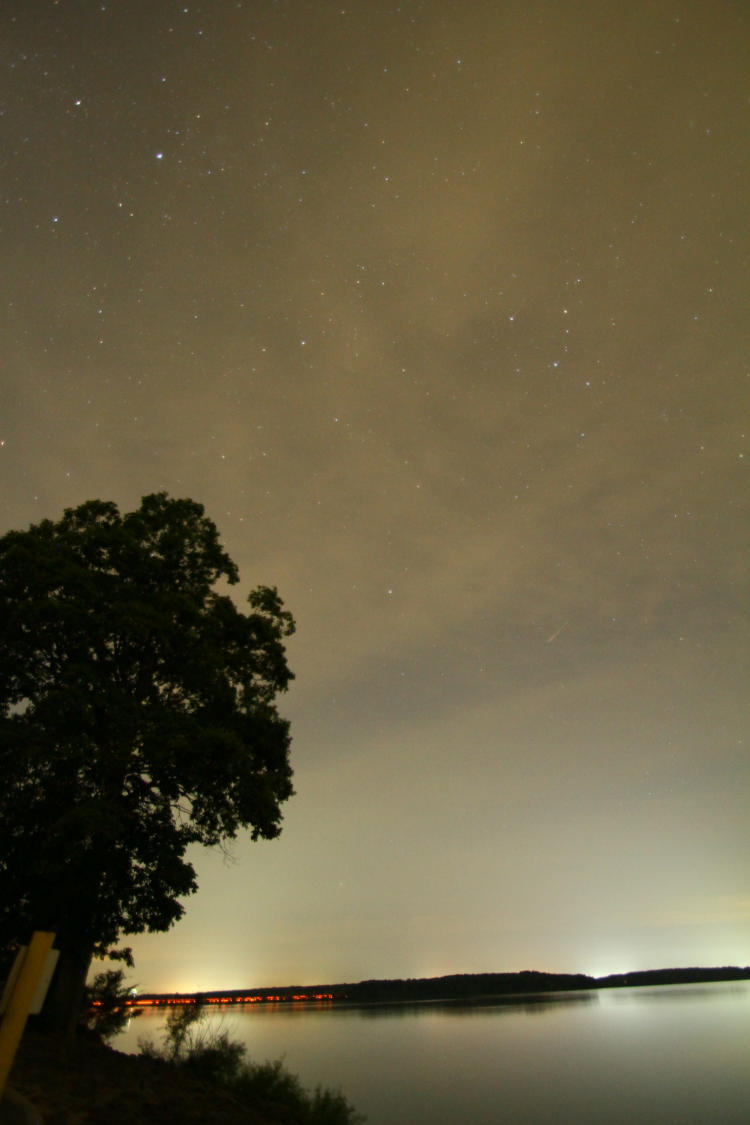
It helps, of course, if you know where to look, which is within the darker band that extends from the middle of the tree. And so you know, this one overlaps the view of the previous, being to the left; the two bright patches from ‘civilization,’ on the horizon at the right (yes, i did not level the camera well, hush,) match the same on the left horizon in the previous images.
But the amazing meteor capture! Let’s zoom in:

Yeah, that’s… a little scratch on the film, except I wasn’t using film. It was one of the basic meteors, a 1/4 second don’t-blink “shooting star” that meets the bare minimum requirements and nothing more. Not the kind of thing that I was after.
BUT, I got two that evening!

That’s even harder to find, isn’t it? I probably wouldn’t even have found it on reviewing the photos later, except that I’d seen this one when it happened, too. Very close to the previous, it sits at the bottom edge of the dark band, extreme right edge. Or, you know, this:

This is again full-resolution, and we’re concentrating on the streak on the right, and not the streak on the left, which is a high-altitude, very distant aircraft. This particular location is reasonably dark and has much better views to the north and east, and very minimal air traffic, quite opposed to Jordan Lake which sits way too close to the airport – if you’re familiar with air traffic lanes, they often pass over airports to use their radionav beacons, even when the traffic isn’t landing anywhere close by.
Now, I pointed out the overlap so you’d know roughly where the radiant is, and that neither of these two were really emanating from it, though with the 10mm lens centered on it I might have gotten them into the frame anyway – not with the 18mm though. In fact, in all three nights I think I saw perhaps two that might have charitably been said to emanate, though neither would been caught if you were concentrating solely on that region.
But with three different sessions, from four to six hours of viewing, I was at least putting some effort into getting something and still netted just these two crummy blecchs while seeing maybe eight, nine? Not at all what I’m trying to accomplish, and believe me, I keep telling myself that the really good image will be snagged, one of these days – it certainly won’t if I don’t try. But results like these aren’t encouraging in the slightest.
Anyway, a last for giggles, as some of the clouds had finally dissipated; yes, it’s me, and color-corrected, but I couldn’t correct the aspherical wide-angle lens distortion – I’m not actually that pin-headed…




















































